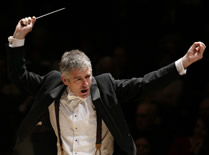Under the leadership of guest conductor Joshua Weilerstein, whose gestures portrayed changing characters and colors with subtlety, the North Carolina Symphony gave a memorable performance of Edward Elgar’s Enigma Variations. While this was the title and centerpiece of the concert, the program also featured several other delightful gems. First on the program was “Dark Sand, Sifting Light,” an exploratory work by up-and-coming New York composer Julia Adolphe. This piece starts sparsely, with wire brushes on the snare drum setting the ambience. Instruments enter for short phrases seemingly at random, but of course this is all carefully measured; at this point Weilerstein was akin to a painter throwing spots of color with intentionality. As the texture expands and grows, many different percussion instruments are used along varying instrumental timbres, creating a unique sound. Viola and clarinet solos were especially compelling, as well as an extremely high and delicate violin solo that appeared throughout the piece. A sense of unrest grows to an arrival point of controlled cacophony, which then dissipates as the music comes to a close.
The wonderful tone and phrasing of the NC Symphony’s own Principal Horn, Rebekah Daley, shone in Strauss’s Horn Concerto No. 2 in E flat. There is barely a single instance of sadness or melancholy in this concerto; instead, beautiful melodies abound through interplay and imitation between horn and orchestra. Daley’s mellow tone was absolutely gorgeous from the beginning, with phrasing that not only matched the orchestra’s melodies but also stood on its own. In the second and third movements, passages that necessitated a sharper tone were expertly controlled. The third movement, a playful Rondo, had the most virtuosic passages of the three movements. Buoyant arpeggios in the horn abounded; building off the orchestra’s energy to a crescendo that was graceful yet dynamic.
Leading the second half of the concert was Latvian composer Pēteris Vasks‘ Epifania, an instinctively mournful yet stirring work for string orchestra. The dissonance and grief here was a welcome contrast to the first half of the concert; Epifania reminded this listener of the feeling of surveying some terrible tragedy’s aftermath. Intense, dramatic crescendos occured, but were suddenly pulled back, creating a pulsing feeling of instability. By the end, the music faded away with the violins playing high, chilling notes and the basses with an eerie chromatic scale that dissipatedd into the air.
Elgar’s Variations on an Original Theme, Op. 36, is an orchestral classic due to both its musicality and the stories behind each movement. Written as a tribute to fourteen people whom Elgar held dear, the work is steeped in mystery around the origin of an unknown theme that fits all fourteen variations. One of the best things about the Enigma Variations musically is the intriguing contrasts it provides, both between and within movements. The music is at times even abrupt or humorous, depending on the character being portrayed. Such exemplary contrasts occurred between movements three and four (“R.B.T.” and “W.M.B”). Movement three was humorous in style, with a sliding pattern in the woodwinds and playful gestures from Weilerstein, before suddenly diving in to the fourth movement, with its vivacious melody and boisterous timpani and brass. The orchestra’s trombones in particular shone in movement seven (“Troyte”) with their melody in this section that was brief, but full of forward motion. Movement nine, “Nimrod,” is the most-loved for a reason – its graceful, leaping melody is heart-wrenching. Certainly, the orchestra did this justice, moving to a climax of the melody that was both musically and emotionally invested. The final variation, Elgar’s musical self-portrait, is a triumphant smorgasbord of previous variations and themes, punctuated by huge united chords. Weilerstein did a wonderful job of preparing these transitions specifically as well as leading beautiful phrasing, both in this movement and throughout the concert.
This performance repeats Saturday, October 22. See our sidebar for details.











